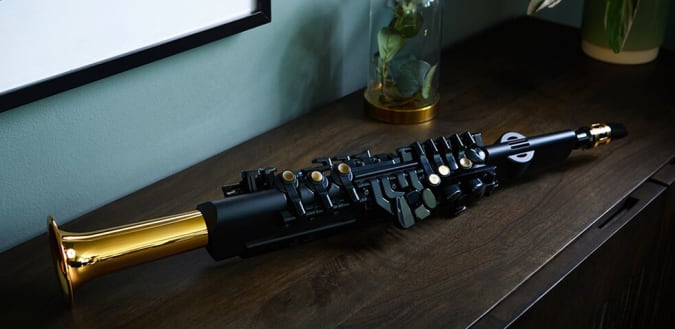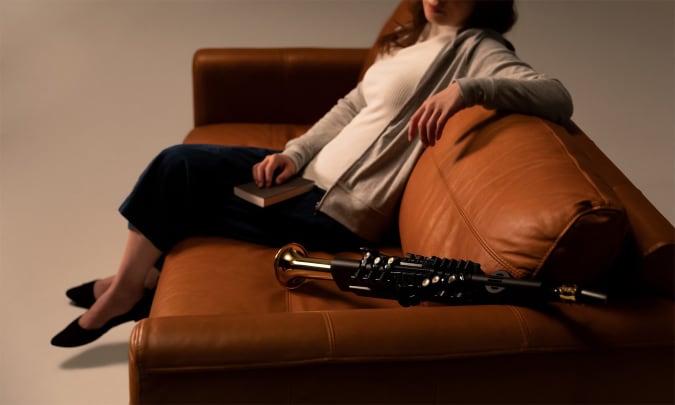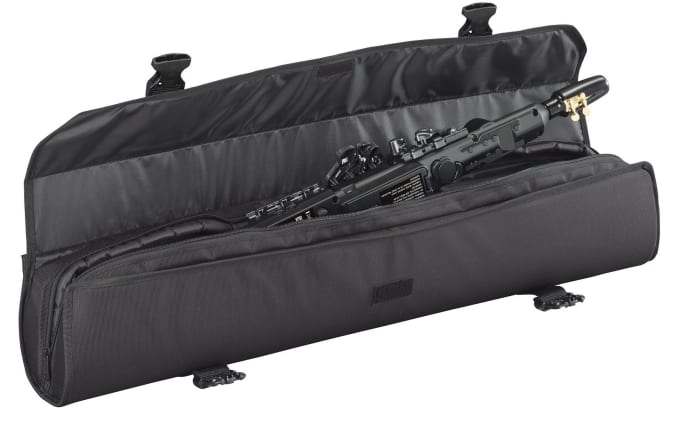There’s a move perfected by middle school orchestra members — mainly clarinet players, in my experience — that emerges directly after a musician makes a jarring mistake during a performance. The player will stop and look down at their instrument in shock, as if it had just grown sentient and created the former nasty sound of its own volition. They’ll shake their head as if to say, “Jeez, it’s so hard to find a reliable instrument nowadays,” and then rejoin the performance, hoping their audience bought the act.
I thought of this phenomenon while I was playing Yamaha’s YDS-150 Digital Saxophone the other day. I played alto and tenor saxophone regularly for about 10 years, from fourth grade through marching band and orchestra in my final year of high school. After that, I played less often, and nowadays I rarely touch the tenor that’s stashed in my closet. It’s been over 10 years since senior year, and honestly, when the YDS-150 showed up at my door, I wasn’t even sure if I would remember how to read sheet music.
Turns out, I did. I loaded up a few songs on Flat and gave them a try on the YDS-150, and the fingerings flowed naturally. I was about halfway through the solo from “Oh Bondage! Up Yours!” by X-Ray Spex, happy to be playing again and incredibly pleased that I had retained some skill, when suddenly, the sax stopped making sound. I increased my air pressure and — nothing. I pulled the instrument away from my mouth and looked down at it in confusion, as if it had developed a mind of its own.
Only, this time, it kind of had. The batteries in the YDS-150 had died in the middle of my song, and the sax shut itself off. It made me think those middle schoolers might be onto something, after all.

Yamaha
“The sax shut itself off” is a strange phrase to type, and I find it difficult to express the exact feeling of surreality that comes with changing the batteries on an instrument that, in my mind, is solidly acoustic. But, that’s my own hang-up. After swapping out the four AAA batteries above the thumb rest and booting up the sax again, I quickly forgot about my anxiety over the unceasing progress of technology, and continued to have a fantastic time playing old favorites.
The YDS-150 is striking: It’s closest in size and shape to a soprano sax, and its body is matte black with pearlescent keys and a brass finish on the bell. The contrast between black and metal is tactical and sharp. The YDS-150 is also light — so light that I didn’t feel the need to use the neck strap for most of my playtime. As a recovering tenor player, this is a dream come true.
The electronic benefits of the YDS-150 far outweigh the potential for it to shut down in the middle of a song, especially considering it flashes a warning light when the batteries are running low, and it comes with a micro-USB power cable that can keep it running as long as it’s plugged in.

Yamaha
The sax can connect to a speaker or headphones via a stereo-mini cable, and it can receive input via Bluetooth from a phone, tablet or computer. This allows players to hear and play alongside backing tracks from these devices. However, it can’t output sound via Bluetooth, meaning hooking up wireless earbuds isn’t an option. Wired headphones work just fine, but this feels like a missed opportunity for the AirPods era.
The instrument has 73 pre-programmed voices for soprano, alto, tenor, baritone and non-sax sounds, and it also allows players to input and save custom channels. These are editable in the YDS Controller app, which is incredibly convenient. After connecting the sax to the app via Bluetooth, players are able to edit voices, and also permanent settings like tuning, key response, reverb type, breath pressure resistance and breath response, all of which are applied immediately to the instrument.

Yamaha
There’s a separate tab just for fingering information and editing, allowing players to not only look up the standard, pre-loaded settings, but also change the button arrangement for any note. This is useful for accessibility reasons, and it provides potential shortcuts in performing tricky or experimental songs, too. The coolest function of the fingering tab is how it responds in real-time to any buttons a player presses on the connected YDS-150, automatically sweeping to the associated note diagram.
This feature is particularly useful for folks using the YDS-150 as a practice instrument, which is where I see its benefit. Though the diversity of voices and settings in the YDS-150 is impressive, the sounds that emanate from the instrument are tinny and keyboard-like. While some voices are more realistic than others, there’s no mistaking this thing for an acoustic saxophone. The YDS-150 isn’t quite performance-quality, from my perspective.
This is what one of the saxophonists who helped tune the YDS-150 can do with it:
And this is closer to what I can get out of it:
The YDS-150 costs $1,078, significantly more than a midrange alto or tenor, and Yamaha is marketing it as a studio instrument. And, hey, that’s fair. The YDS-150 is impressive; it contains a breadth of voices in a range of styles, from jazz to electronica to classical, and it packs four separate instruments into a sleek, lightweight container. The sax’s carrying case is slender enough to sling over your shoulder like a yoga mat. That’s magic.
The YDS-150 is worth the price of admission, though it’s not a replacement for an acoustic soprano, alto, tenor or bari sax. It’s a ridiculously customizable practice tool, an unexceptional performance device and a beautiful instrument all around.
Even when its batteries die.



